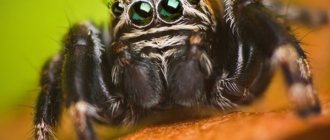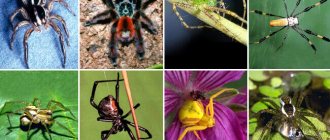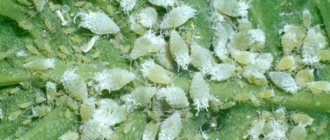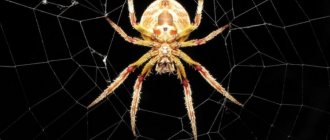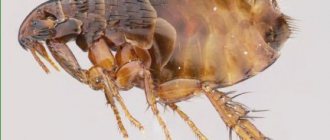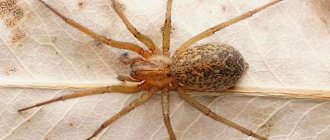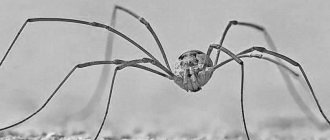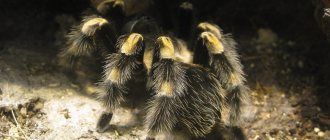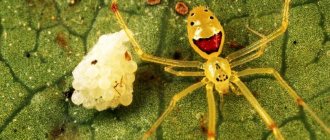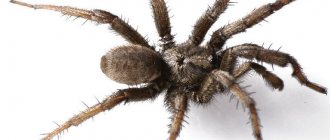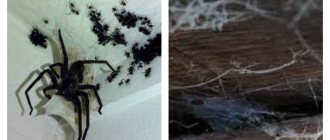SPIDERS
(Aranei), a detachment of the arachnid class, which also includes ticks, scorpions, harvestmen, etc.
Spiders are close to insects in a number of ways, but clearly differ from them, and these groups are related only by a very distant relationship. A well-known characteristic feature of many spiders is the ability to weave complex trapping networks (nets) from a silk-like substance secreted by the arachnoid glands. Some spiders, such as the black weaver spider (black widow) and tropical tarantulas, can inflict very painful bites that can be fatal, but most spiders, although they bite, are not dangerous to humans. Also on topic:
Arachnids
The name of the class Arachnoidea comes from the Greek. arachne - spider. In ancient Greek mythology, Arachne was the name of a girl who was such a skilled weaver that, having challenged the patron goddess of this craft, the goddess Athena, to a competition, she wove a fabric better than her. The annoyed goddess turned her rival into a spider, declaring that from now on Arachne and her entire family would spin and weave until the end of time.
In total, approx. 30,000 species of spiders. The length of their body ranges from 0.1 to 5 cm. The main food is the liquid tissue of insects, which spiders catch by rushing from ambush or using a web. Spiders are found at almost all inhabited latitudes and altitudes: they were found on the slopes of Everest 6700 m above sea level and caught (juveniles) 600 m from the surface of the earth. Some species live in water. While settling, juveniles of a number of small species climb onto the ends of blades of grass and other towering objects and, raising their abdomen, begin to secrete an arachnoid thread, which is picked up by the air flow and, having reached a sufficient length, carries the animal on itself. This type of summer occurs in certain seasons and is especially noticeable in the “Indian summer”, when in the air you can see entire “flying carpets” of dozens of intertwined cobwebs. This unique method of settlement allows spiders to travel vast distances and even reach islands lost in the ocean.
Also on topic:
SYSTEMATICS OF ANIMALS
The web and the construction of nets.
The ability to secrete arachnoid thread is a characteristic feature of almost all spiders. The material for it is formed in special glands located in the back of the abdomen, and the so-called spider warts. Some spiders produce threads of different (up to six) types and use each of them for very specific purposes.
Also on topic:
MIMICRY
As the spider moves, it continuously secretes webs, which, like a climber's safety rope, it periodically attaches to the surfaces it passes over. That is why a disturbed spider can almost always cross its legs, fall from the support and, hanging on an extensible thread, descend along it to the ground. When prey gets into the net, the spider usually entwines it with a web and only then kills it with poisonous claws (chelicerae) and sucks it out.
Probably the most interesting feature of spiders is the construction of trapping nets from their webs. Their forms are very diverse and often very beautiful. Not all spiders use their webs to catch insects, but each species weaves it in a specific way, and the resulting structure may well serve as a taxonomic character. The most beautiful, so-called Wheel-shaped, nets are built by orb-weaving spiders from the family of spiders (Araneidae). First, the spider climbs to a high place, usually near a path or other open space, and secretes a very light thread, which is picked up by the breeze and, accidentally touching a nearby branch or other support, is braided around it. The spider moves along this thread to a new point, strengthening the web along the way with an additional secretion. In a similar way, two or three more relatively thick “cables” are laid, making up a closed frame, inside which the catching structure itself will be located. Usually the webs are oriented more or less vertically, but some species of spiders build horizontal webs. Threads-radii are stretched between the sides of the frame, connecting in the center, like spokes in the hub of a wheel. Now, starting near this place, the spider moves towards the periphery in a spiral, leaving behind itself a thread attached to the radii, the distance between the turns of which is determined by the span of its limbs. While the web is not yet sticky, but having reached the outer frame, the spider again moves in a spiral, but with more densely spaced turns, back to the center, this time forming a thread, which, unlike the previous ones, is covered with droplets of sticky secretion. As this actual catching spiral is laid, the thread of the first non-sticky spiral is bitten off and thrown away. Obviously, it served only as a kind of scaffolding.
When the nets are ready, the spider moves to their center or to a shelter located next to the net and waits for any flying insect to stick to the web. Usually the entire structure works for one night, and by the morning it is torn apart in many places.
One of the most beautiful webs is woven by the common species Argiope aurantia.
, a large spider with a black and gold pattern on its body.
Its extensive spicate nets are characterized by a zigzag thread running vertically through the center of the structure. The shape of the fishing net of other species is completely different. For example, in representatives of the genus Frontinella
it resembles a cup on a saucer.
Funnel web spiders (family Agelenidae) have a web similar to a net, and spiders of the family Gnaphosidae build tubular shelters from the web under stones and other objects, where they hide between hunting trips. An unusual wheel-shaped network of golden threads is built by the species Nephila clavipes
. This large spider, common in the southern United States, is characterized by legs with tufts of hairs.
The ability of spiders to secrete a thread resembling silk has repeatedly led to attempts to use them like silkworms, but these experiments were not successful. The main difficulty is that spiders must be fed with live insects, and to obtain one kilogram of fiber quickly enough requires more than 1.3 million spiders! At one time, crosshairs of optical instruments, such as theodolites, levels and telescopes, were made from spider webs.
Many spiders do not build webs at all and simply hunt prey from ambush. This is characteristic of representatives of such families as wolf spiders (Lycosidae), jumping spiders (Salticidae) and theraphosid tarantulas (Theraphosidae). Jumping spiders, for example, track victims using their keen vision and catch them in one jump.
Interesting Facts
Spiders inspire fear in people, but at the same time they inspire interest. Therefore, they are studied and even raised at home as pets.
Flying spiders
There is evidence that some species of spiders can fly. And this is not to instill fear in the impressionable. This method is a protection and a method of movement.
Spiders with a tail
There were individuals that had a tail. Unusual tailed spiders and their descendants.
Web
Spider web is a strong and stable material; it can stretch several times and return to its original position.
Theraphosides.
One of the most interesting American spiders is the species Dugesiella hentzi
.
This is a large animal, the leg span of which reaches 15 cm. The body color is dark brown, so in general the animal is, to put it mildly, unattractive. People tend to be afraid of it, but this spider is relatively harmless: its bite is no worse than a bee’s. It is common in the southwestern United States and is more or less nocturnal. The main enemy of this species is a wasp from the genus Pepsis
, the name of which is translated from English as “big blue tarantula hawk”. She paralyzes the spider with a sting and drags it into her burrow to feed the larva. The bites of some tropical theraphosids are very poisonous even to humans. Representatives of this family often live up to 20 years.
Interesting classification
Everyone knows that there are lovers of large tarantula spiders who classify their favorites depending on their speed characteristics. For example:
- For Dummies". These are slow-moving members of this species that many people like to film. They can sit quietly on the palm of a person and move extremely slowly.
- For the “advanced”. These arthropods move quite quickly, so it’s unlikely to be captured on video.
- For professionals. They move so quickly that it is unlikely to notice in which direction the arthropod disappeared.
If we take into account such speed characteristics, it is not difficult to imagine how many species humanity does not yet know about.
Ctenizidae.
In some areas of the United States, interesting spiders from the family Ctenizidae are found. They vary in size and reach a length of 2.5 cm; The color of the massive body is dark. These spiders dig holes in the ground and line their walls with cobwebs. A characteristic feature of such shelters is a tightly fitted door, which is very difficult to open when the spider is holding it from the inside. It has been established that in this case the animal can withstand a pulling force equal to almost a pound: for a person it is equivalent to 10 tons. From time to time, ctenisids leave their burrows to hunt. Their main enemy is a type of wasp that can open the door of their lair or attack spiders when they are outside.
Habitats
Arachnids exist where conditions permit, i.e. absolutely in every corner of the planet, with the exception of areas with severe frosts and regions that are constantly covered with a large layer of ice. Basically, arthropods are considered terrestrial inhabitants, but there are spiders that live in dug burrows or nests, leading an active lifestyle only at night.
Tarantulas and other mygalamorph species live in equatorial trees and bushes. Drought-resistant species settle in rock crevices, burrows and other shelters located at ground level. Diggers prefer to settle in groups, in separate burrows, the depth of which can reach up to 50 cm. Some species cover their houses with special screens, which they make from silk, soil or grass.
Haymaking spiders can often be found in damp and dark places
The so-called hay spiders prefer to live in dark and damp places, such as caves, uninhabited destroyed buildings, basements, and also in burrows that have been abandoned by various animals. Centipedes live in living quarters, on windows on the south side, hanging upside down.
Jumping spiders are able to survive almost everywhere, with the exception of icy places: in the desert, in forest-steppes, in the mountains, on stone and brick buildings.
Karakurt mainly lives in wormwood wastelands, where spiders are often trampled into the soil by herds of domestic animals. They can also be found on the rocky slopes of ravines and on the coast of artificial canals.
Water spiders.
Relatively large spiders of the genus Dolomedes
, which can run along the surface of stagnant bodies of water and even dive under water, holding on to plants. These spiders feed on insects, fish fry and tadpoles.
The silverback spider lives in Europe, spending most of its life underwater in places where there is little or no current. This is probably the most unusual spider in the world, considering that it, like all representatives of its class, breathes atmospheric air. In the spring, it goes under water and stretches a horizontal network of cobwebs with very small cells between the plants. Then, rising to the surface, it exposes the end of the abdomen, covered with non-wettable hairs. Air collects between them, which the spider, in the form of a bubble held by its legs, drags into the depths and shakes off under its web. It does not allow the bubbles to float up and after repeated such flights it bends into a bell the size of a thimble or even larger, supported from the inside by an air chamber. The spider hides inside it, inaccessible to most enemies, immediately lays eggs, hatches young and overwinters. The bells of the male and female living separately are connected to each other by a bridge made of cobwebs.
Poisonous spiders.
It's common to be afraid of spiders. Indeed, almost all of them are armed with poisonous claws, but only a few species are dangerous to humans. In the USA, you need to beware of two of them - the “brown recluse” ( Loxosceles reclusa
) and "black widow" (
Latrodectus mactans
). The length of the first is only 0.6 cm. This spider lives in the Midwest, often in homes where it hides behind furniture. At the site of its painful bite, an ulcer forms, which may never completely heal. The black widow spider is found throughout most of the United States. The bite of this species causes severe pain and can lead to death due to the neurotoxin injected into the wound. The female's body is shiny black with bright red spots. There is usually a red hourglass pattern on the underside of the abdomen. The male is much smaller than the female, but similar in coloring. The name “black widow” is explained by the fact that the female often eats her partner after mating, which, however, is a fairly common phenomenon among spiders. This species is not aggressive, and spiders usually try to hide from humans, but if picked up, they often bite.
Literature
- Azheganova N. S.
A short guide to spiders (Aranei) of the forest and forest-steppe zones of the USSR. - L., 1968. - 150 p. - Akimushkin I.
First settlers of land. - M.: Mysl, 1972. - 206 p. - Life of animals. Encyclopedia in six volumes / General edition of Corresponding Member of the USSR Academy of Sciences, Professor L. A. Zenkevich. - M.: Education, 1969. - T. 3. - 576 p.
- Marusik Yu. M., Kovblyuk N. M.
Spiders (Arachnida, Aranei) of Siberia and the Russian Far East / Rep. ed. Striganova, Bella Rafailovna. - M.: KMK, 2011. - 344 p. — 400 copies. — ISBN 978-5-87317-772-1. - Mikhailov K. G.
Catalog of spiders (Arachnida, Aranei) of the territories of the former Soviet Union. - M.: Zoological Museum of Moscow State University, 1997. - 416 p. - Seifulina R. R., Kartsev V. M.
Spiders of central Russia: Atlas-determinant. - M.: Fiton+, 2011. - 608 p. — 1000 copies. — ISBN 978-5-93457-348-6. - Tyshchenko V.P.
Identifier of spiders of the European part of the USSR. - L.: Nauka, 1971. - 282 p. - Starobogatov Yu. I. 1990. System and phylogeny of Arachnida (analysis of the morphology of Paleozoic groups).
Journal of Paleontology, 24: 4–17. - Brignoli, P. M. 1983. A catalog of the Araneae described between 1940 and 1981. Manchester Univ. Press, Manchester, 755 pp.
- Platnick, N.I. 1989. Advances in Spider Taxonomy 1981–1987: A Supplement to Brignoli's A Catalog of the Araneae described between 1940 and 1981. Manchester Univ. Press, Manchester, 673 pp.
- Platnick, N.I. 1990. Spinneret morphology and the phylogeny of ground spiders (Araneae, Gnaphosoidea). Amer. Mus. Novit. 2978: 1-42.
- Platnick, N.I. 1993. Advances in spider taxonomy 1988–1991, with synonymies and transfers 1940–1980. New York Entomol. Soc., New York, 846 pp.
- Platnick, N.I. 1998. Advances in spider taxonomy 1992–1995 with redescriptions 1940–1980. New York Entomol. Soc., New York, 976 pp.
- Platnick, N.I. 1999. Dimensions of biodiversity: targeting megadiverse groups. In: Cracraft, J. and F. T. Grifo (eds.), The Living Planet in Crisis: Biodiversity Science and Policy. Columbia Univ. Press, New York, pp. 33-52.
External building.
Spiders, unlike insects, do not have antennae (antennae) or jaws. The body is covered with an external skeleton (exoskeleton) and consists of two sections - the cephalothorax, formed by the fused head and chest, and the abdomen. They are connected to each other by a narrow stalk. At the anterior end of the cephalothorax there are simple eyes, the location of which serves as an important classification feature. Most spiders have four pairs. The cephalothorax bears six pairs of limbs. At the front of the head are two downward, jaw-like chelicerae, each of which ends in a sharp claw. It opens the poisonous glands located in these limbs. The second pair are pedipalps, used as palps and grasping structures. In mature males, their ends are modified and are used for mating. Between the bases of the pedipalps there is a small oral opening. All spiders, unlike insects, have four rather than three pairs of walking legs. The last segment of each of them bears at least two claws, and in some species there are many more.
The arachnoid glands open on the underside of the abdomen, usually with six arachnoid warts. In front of them are small respiratory openings - spiracles, or stigmas.
Meaning in nature
It is worth considering two meanings of spiders in nature:
- Practical. In this case, with the knowledge gained about spiders, this significance comes down to the harm that they cause with their poisonous bites. However, among the variety of species, there are spiders that can be beneficial, since they destroy quite dangerous and harmful insects.
- Biological. It comes down to the use of poison by spiders, as a result of which the prey is killed.
Thus, due to their ability to eat harmful insects, spiders are beneficial. However, if a large concentration of representatives of this detachment was noticed, it is worth thinking about ways to destroy them.
Internal structure.
Spiders feed on liquid tissues sucked from their victims, mainly insects. The digestive system of spiders consists of a specialized sucking stomach, another stomach with blind outgrowths, and an intestine surrounded by a digestive gland (“liver”) and opening at the end of the body with an anus.
The circulatory system is not closed. It consists of the heart, arteries, veins and spaces (sinuses) between organs, washed by colorless blood (hemolymph). The heart is a pulsating tube with holes (ostia) that runs along the dorsal side of the body cavity. Unlike insects, it is not divided into several chambers.
Spiders, as already mentioned, breathe air. Their respiratory organs are the trachea and lungs, called pulmonary books. Each such book consists of a bag, one of the walls of which is folded in the form of numerous leaf-shaped folds, reminiscent of pages. They exchange oxygen and carbon dioxide between the blood and the air. The lungs open to the outside with spiracles. The most primitive spiders have two pairs of pulmonary books; in more advanced ones, one or both of them are replaced by trachea piercing the body.
The excretory system consists of a pair of coxal glands in the cephalothorax and the so-called. Malpighian vessels in the abdomen, which open into the intestine.
The nervous system is similar to that of insects. It consists of an abdominal trunk with branches extending to different organs and ganglia collected in the cephalothorax into a large subpharyngeal node, above which is the suprapharyngeal node - the “brain”. Sensory hairs are located on the pedipalps and walking legs.
The reproductive organs are represented by ovaries in females and testes in males. Their openings are located below at the base of the abdomen.
Reproduction.
Fertilization in spiders is a very complex process. After mating, the female often eats the male. The eggs are laid in a web cocoon, which the female carries with her or attaches to a solid object, such as a plant. In some spiders, including the species Argiope aurantia
, these cocoons are clearly visible on trees, especially in winter after the leaves have fallen.
Spiders hatched from eggs soon begin to weave their own trapping nets or disperse through the air, attaching themselves to flying cobwebs. See also
INSECTS.
